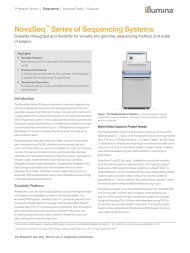Abstracts
ngsfinalprogram
ngsfinalprogram
Create successful ePaper yourself
Turn your PDF publications into a flip-book with our unique Google optimized e-Paper software.
Oral Presentation <strong>Abstracts</strong><br />
n S1:3<br />
THREE MONTHS OF SURVEILLANCE OF S.<br />
TYPHIMURIUM AND S. 1,4,[5],12:I:- IN<br />
DENMARK BASED ON WHOLE-GENOME<br />
SEQUENCING AND MLVA TYPING<br />
M. Kjeldsen, P. Gymoese, M. Torpdahl;<br />
Statens Serum Institut, Copenhagen, DEN-<br />
MARK.<br />
Introduction: Salmonella enterica subsp. enterica<br />
Typhimurium (S. Typhimurium) and its<br />
monophasic variant 1,4,[5],12:i:- are zoonotic<br />
pathogens of significance in both humans and<br />
animals worldwide. In Europe, Salmonella<br />
cause the majority of food-borne outbreaks.<br />
Currently, several laboratories primarily use<br />
pulsed-field gel electrophoresis (PFGE) and<br />
Multiple-locus variable-number tandem repeat<br />
analysis (MLVA) for surveillance and outbreak<br />
investigations of Salmonella. Surveillance<br />
studies based on whole-genome sequences<br />
(WGS) shows good results and are promising<br />
alternatives to conventional methods. In this<br />
study, we evaluate SNP analysis in comparison<br />
to MLVA for surveillance of S. Typhimurium<br />
and S. 1,4,[5],12:i:-. Materials and Methods:<br />
We analyzed all S. Typhimurium and S.<br />
1,4,[5],12:i:- human clinical isolates from the<br />
Danish surveillance program from January to<br />
March 2015. This collection comprises of 40<br />
monophasic S. Typhimurium and 66 S. Typhimurium<br />
isolates, hereunder three outbreaks<br />
defined by MLVA-typing and epidemiological<br />
findings. The relatedness of the strains was<br />
examined by core genome SNP analysis, and<br />
results were compared with those of MLVA<br />
and Multi-locus sequence typing (MLST).<br />
Results: WGS analysis on the collection of<br />
106 strains resulted in close to 5900 SNPs.<br />
A clear correlation between SNP and MLST<br />
analysis was observed. S. Typhimurium ST36<br />
was separated by a deep branch from ST19<br />
and ST34. Isolates of ST34 mainly comprised<br />
monophasic variants and were separated by<br />
440 SNPs, indicating a close relationship<br />
within this group. In correspondence with the<br />
MLVA defined S. Typhimurium outbreaks,<br />
the SNP based tree revealed three clusters of<br />
closely related strains with a few SNP differences.<br />
In one of the outbreaks, MLVA included<br />
35 isolates while the SNP analysis added two<br />
potential outbreak isolates to this cluster. In the<br />
ST34 group, SNP analysis dispersed all MLVA<br />
clusters, including the outbreak cluster (of<br />
eight isolates) located within this group; SNP<br />
queried if one of the eight defined outbreak<br />
isolates should be included. Conclusion: Our<br />
results show that strains with identical MLVA<br />
profiles can be either unrelated or closely related<br />
based on SNP distance determined from<br />
WGS. Using WGS analysis for outbreak detection<br />
seems reliable and in addition, it provides<br />
a higher resolution of the strains relationships.<br />
At present, defining an outbreak solely on SNP<br />
differences is problematic, since the number<br />
of SNP differences allowed within a cluster<br />
have to be considered. This study highlights<br />
the challenges with both SNP and MLVA based<br />
cluster detection and emphasizes the importance<br />
of combining molecular methods with<br />
epidemiological data.<br />
n S2:2<br />
LONG READS SEQUENCING FOR BETTER<br />
SHORT READS SNP ANALYSIS<br />
D. Moine 1 , L. Baert 2 , C. Barretto 2 , C. Ngom-<br />
Bru 2 , M. Kasam 1 , C. Fournier 1 , L. Michot 2 , J.<br />
Gimonet 2 , C. Chilton 2 ;<br />
1<br />
Nestlé Institute of Health Sciences, Lausanne,<br />
SWITZERLAND, 2 Nestle Research Center,<br />
Lausanne, SWITZERLAND.<br />
Whole genome sequencing (WGS) is an<br />
emerging tool for foodborne pathogen characterization.<br />
It can help to identify and type<br />
the bacteria for investigative purposes (source<br />
attribution), factory ecology and trend analysis<br />
in the food industry. This novel approach is<br />
ASM Conference on Rapid Next-Generation Sequencing and Bioinformatic<br />
Pipelines for Enhanced Molecular Epidemiologic Investigation of Pathogens<br />
15



